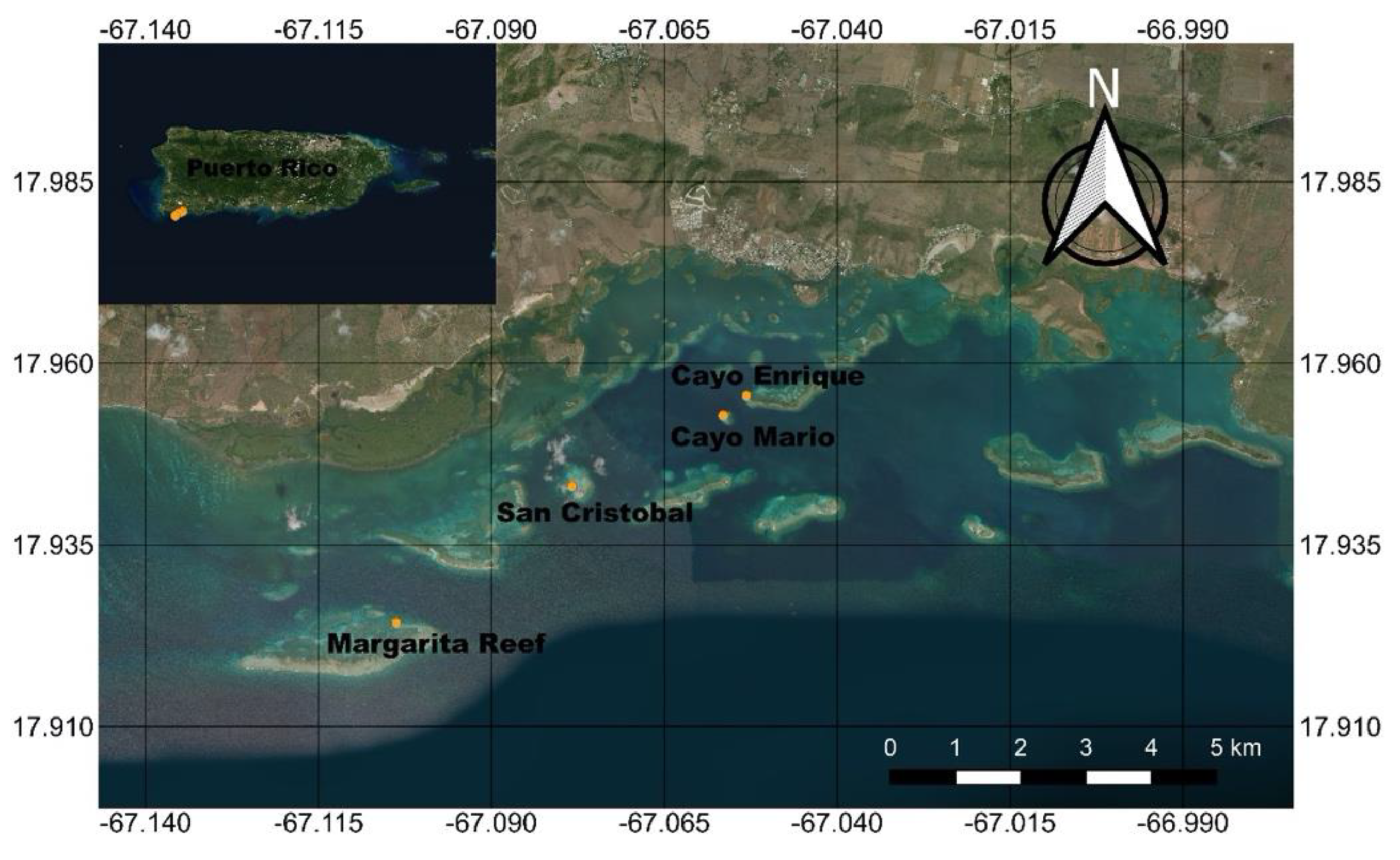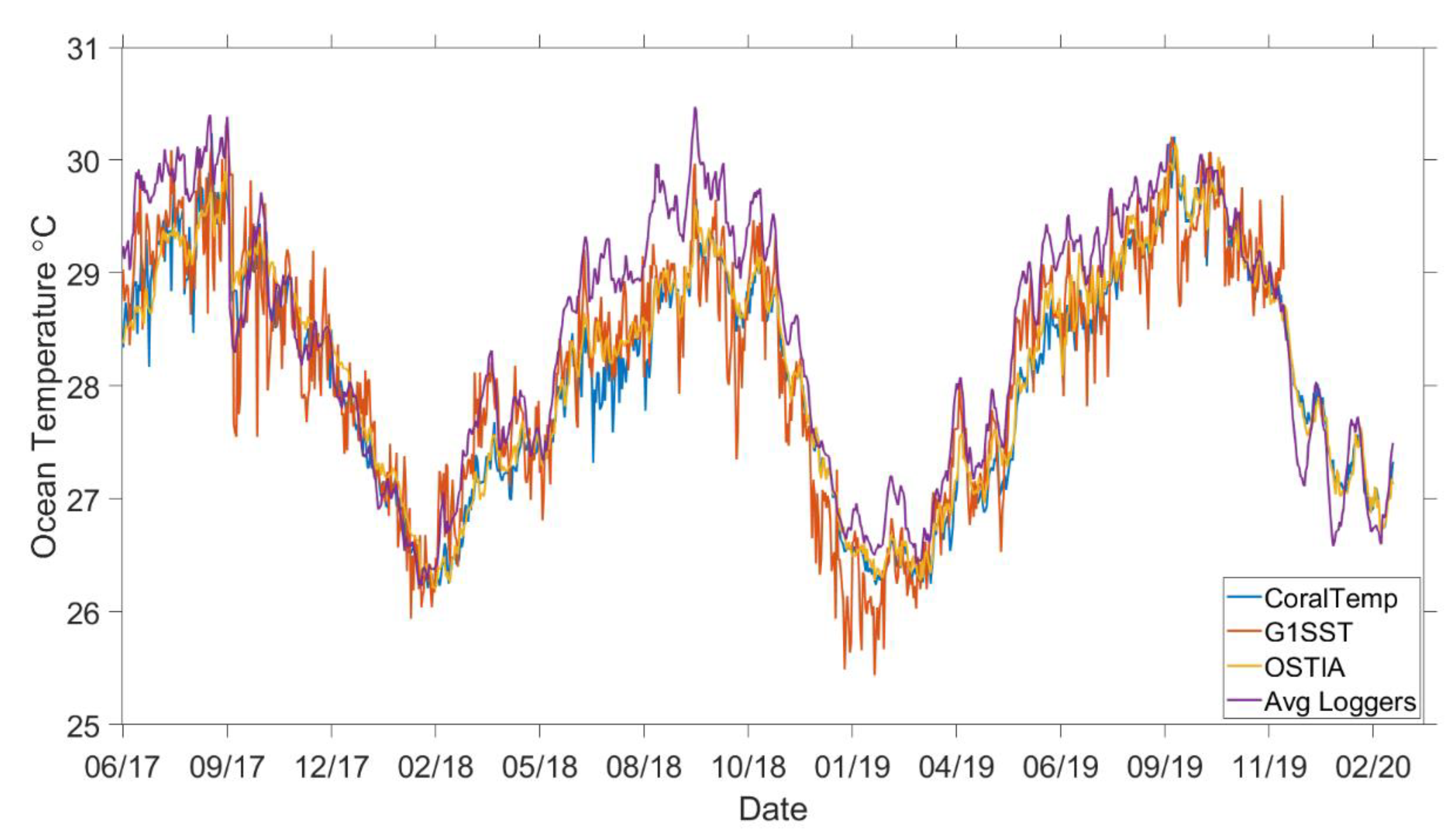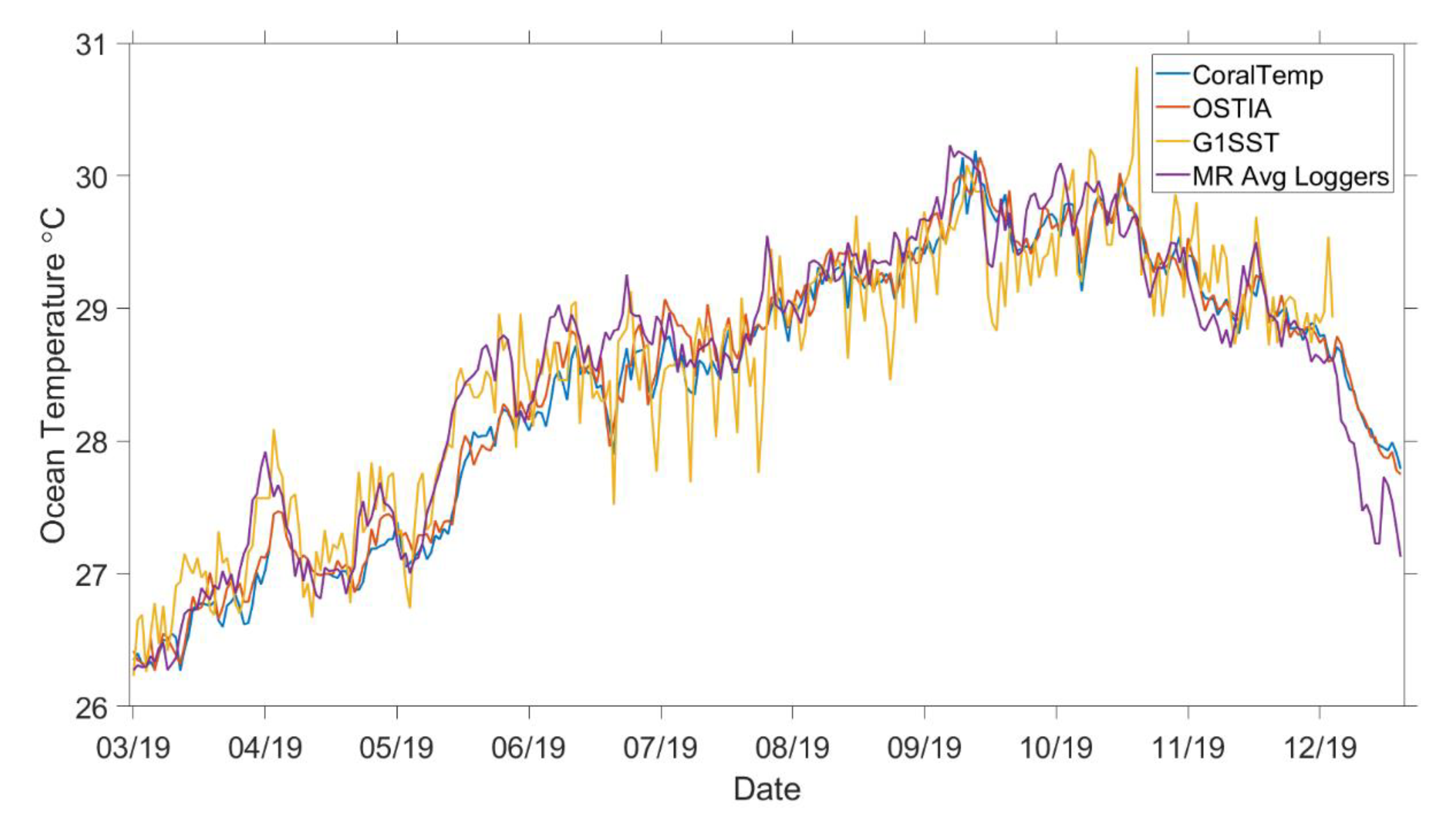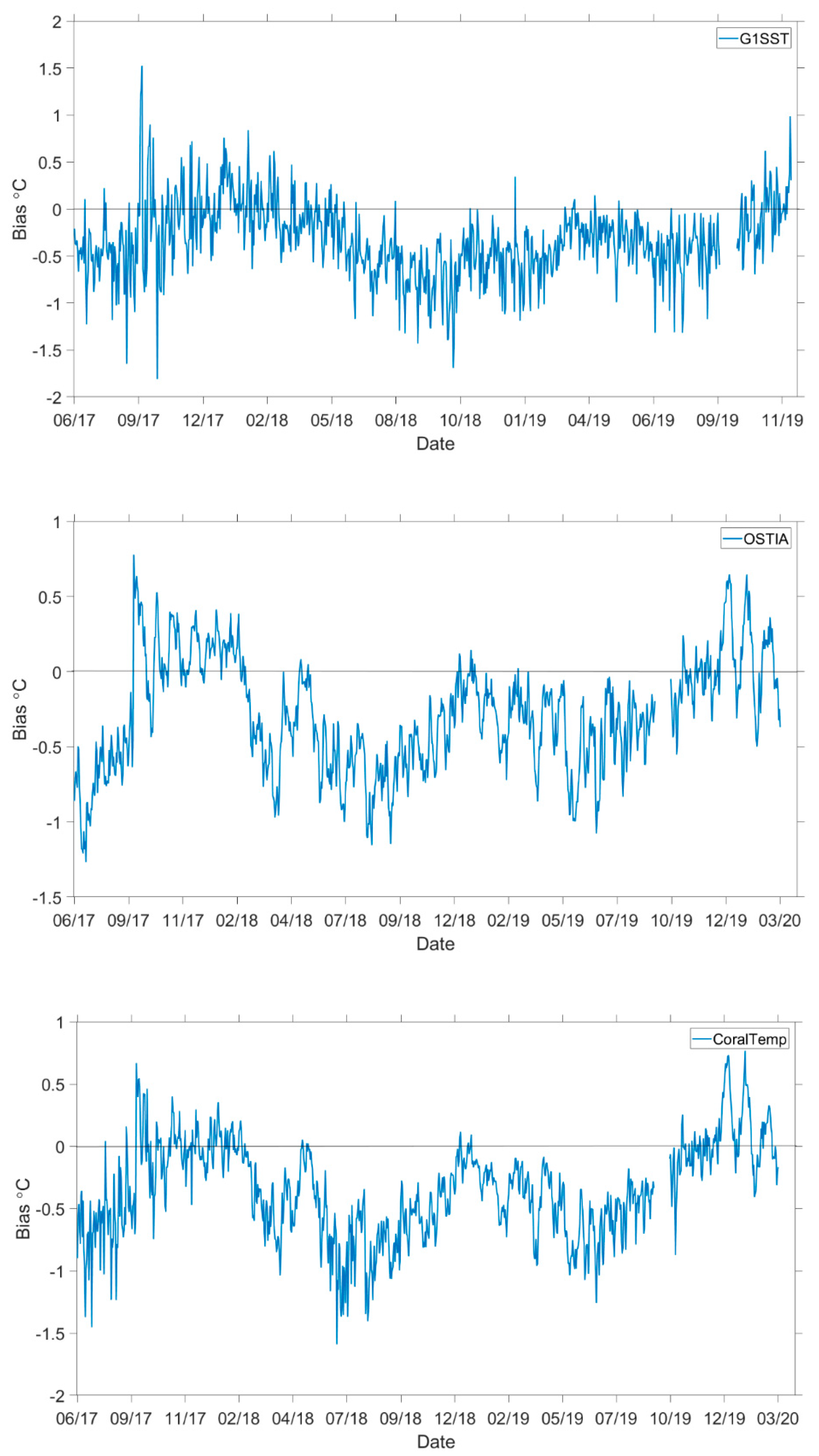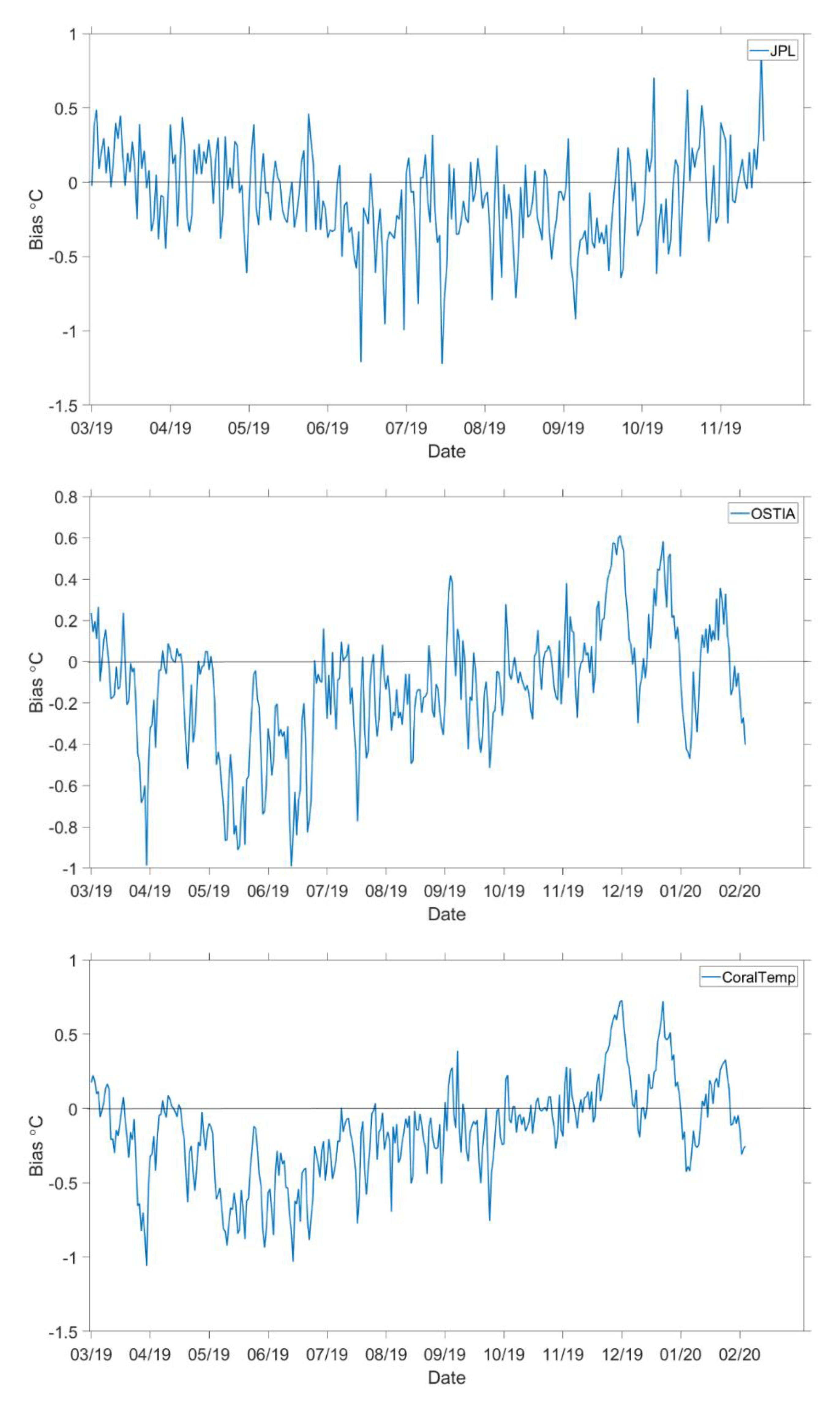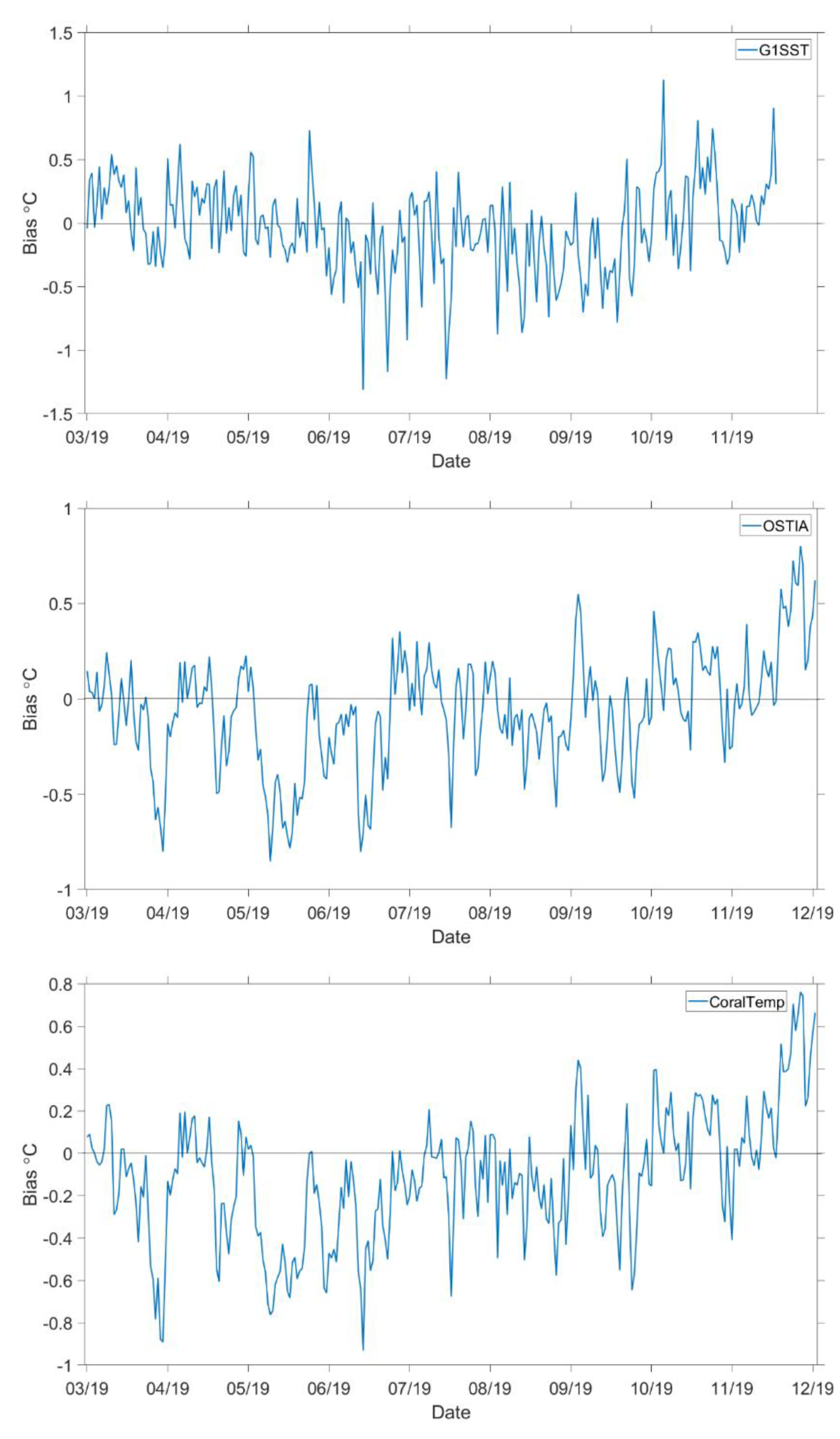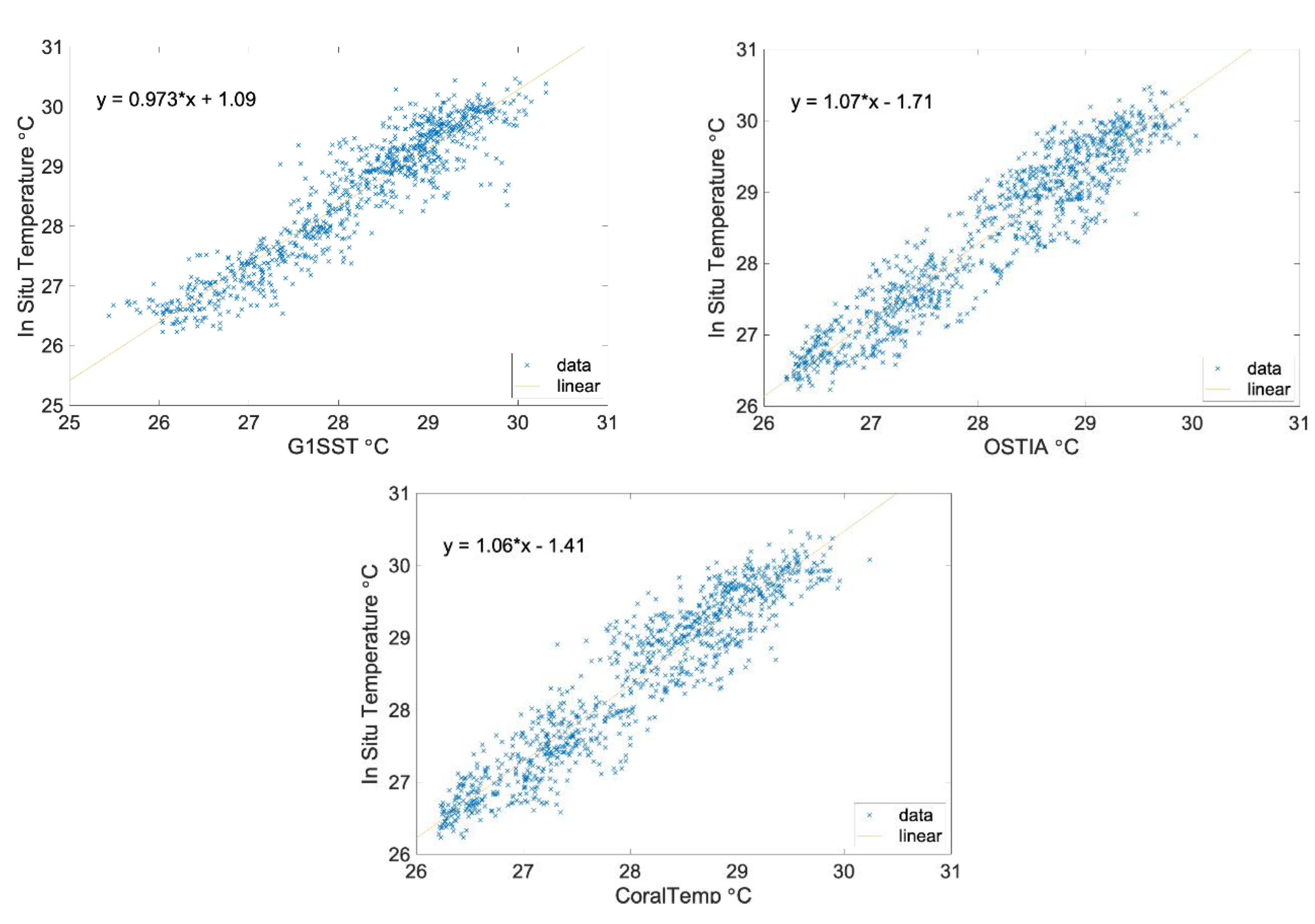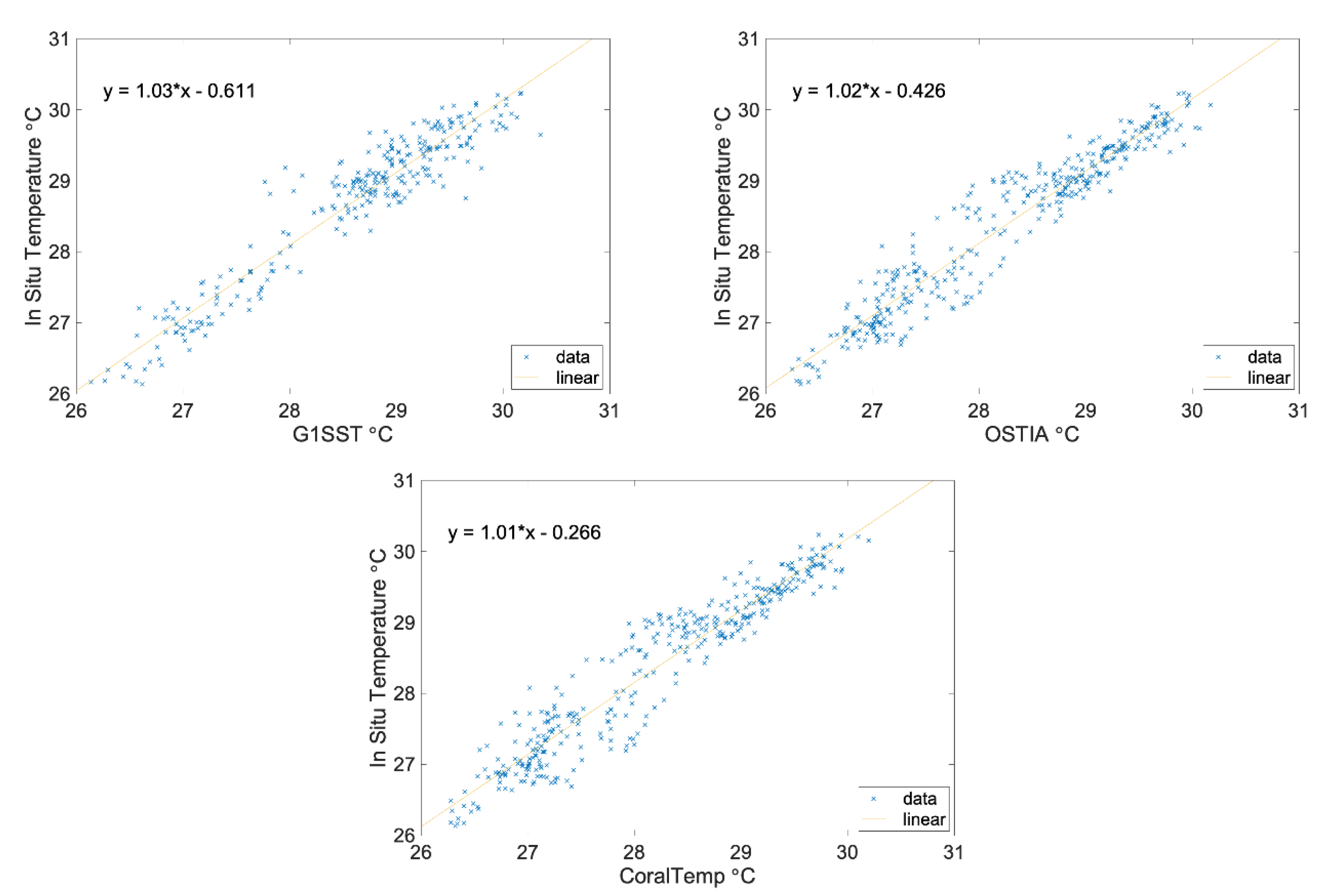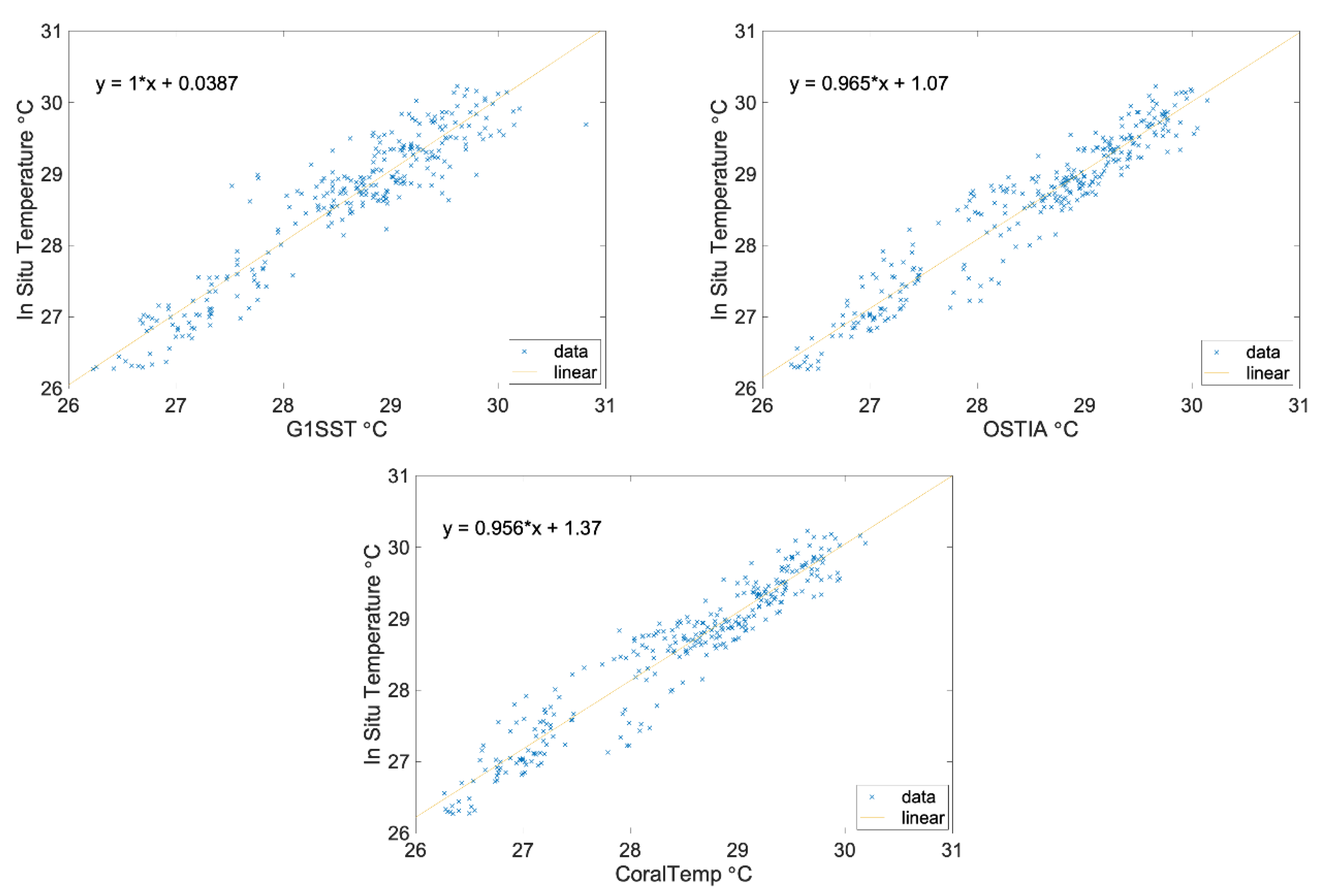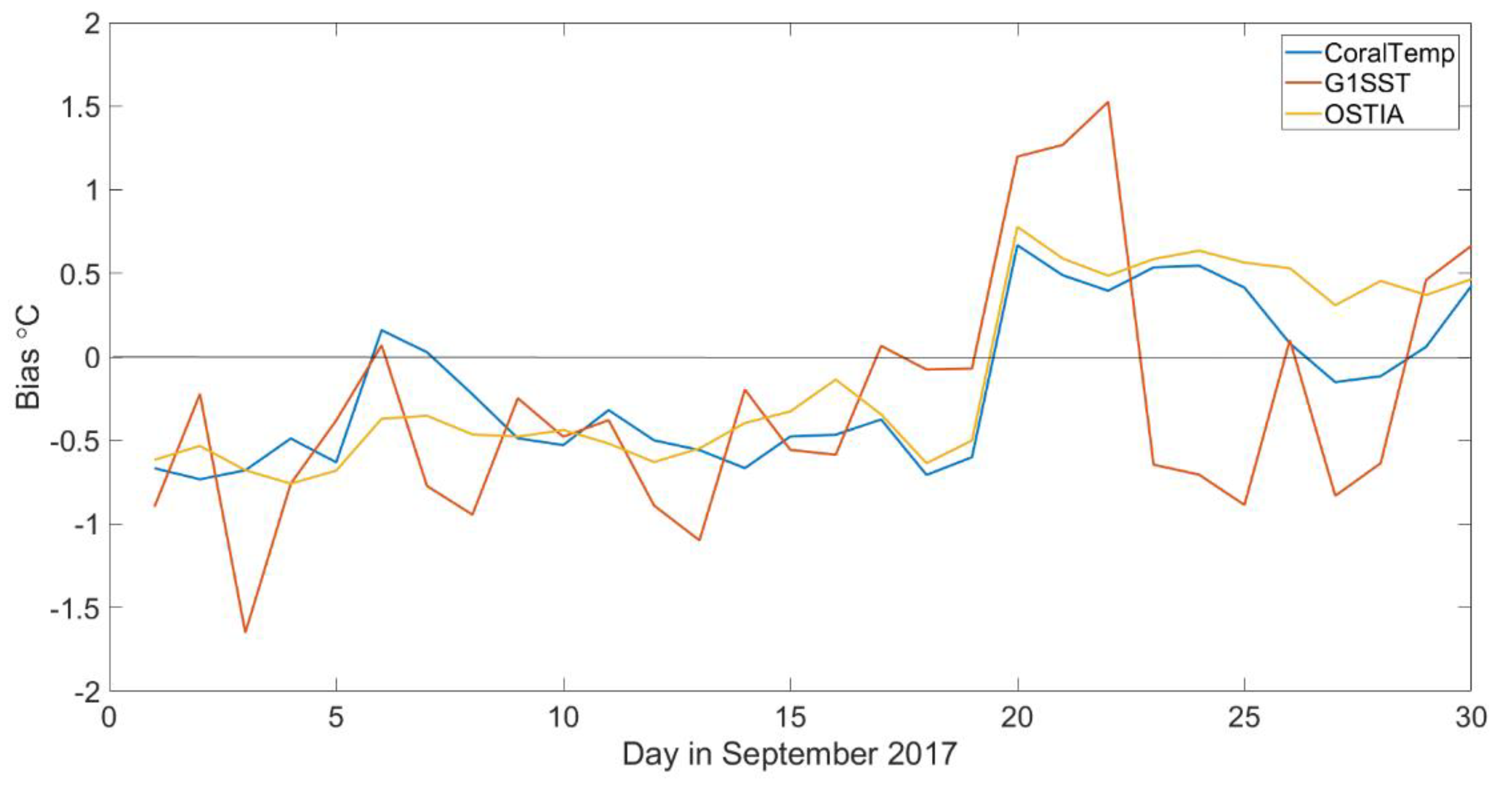Figure 1.
Map of study location, La Parguera, Puerto Rico. During June 2017, six temperature sensors were deployed at Cayo Enrique, and six temperature sensors at Cayo Mario (n = 12 total). The depths ranged from 1–13 m. In March 2019, eight temperature sensors were deployed at San Cristobal between depths of 5–6 m, and another eight were deployed at Margarita Reef at depths between 3–4 m (n = 16).
Figure 1.
Map of study location, La Parguera, Puerto Rico. During June 2017, six temperature sensors were deployed at Cayo Enrique, and six temperature sensors at Cayo Mario (n = 12 total). The depths ranged from 1–13 m. In March 2019, eight temperature sensors were deployed at San Cristobal between depths of 5–6 m, and another eight were deployed at Margarita Reef at depths between 3–4 m (n = 16).
Figure 2.
Time series of temperature data from 30 June 2017–1 March 2020 of the three remote sensing datasets (CoralTemp, G1SST, OSTIA) and the averaged in situ loggers for Cayo Enrique and Cayo Mario.
Figure 2.
Time series of temperature data from 30 June 2017–1 March 2020 of the three remote sensing datasets (CoralTemp, G1SST, OSTIA) and the averaged in situ loggers for Cayo Enrique and Cayo Mario.
Figure 3.
Time series of temperature data from 1 March 2019–1 March 2020 of the three remote sensing datasets (CoralTemp, G1SST, OSTIA), and the averaged in situ loggers for San Cristobal.
Figure 3.
Time series of temperature data from 1 March 2019–1 March 2020 of the three remote sensing datasets (CoralTemp, G1SST, OSTIA), and the averaged in situ loggers for San Cristobal.
Figure 4.
Time series of temperature data from 1 March 2019–24 December 2019 of the three remote sensing datasets (CoralTemp, G1SST, and OSTIA), and the averaged in situ loggers for Margarita Reef.
Figure 4.
Time series of temperature data from 1 March 2019–24 December 2019 of the three remote sensing datasets (CoralTemp, G1SST, and OSTIA), and the averaged in situ loggers for Margarita Reef.
Figure 5.
Time series of the bias (satellite—in situ) temperatures from 30 June 2017–1 March 2020 for Cayo Enrique and Cayo Mario.
Figure 5.
Time series of the bias (satellite—in situ) temperatures from 30 June 2017–1 March 2020 for Cayo Enrique and Cayo Mario.
Figure 6.
Time series of the bias (satellite—in situ) temperatures from 1 March 2019–1 March 2020 for San Cristobal.
Figure 6.
Time series of the bias (satellite—in situ) temperatures from 1 March 2019–1 March 2020 for San Cristobal.
Figure 7.
Time series of the bias (satellite—in situ) temperatures from 1 March 2019–24 December 2019 for CoralTemp and OSTIA, and from 1 March 2019–8 December 2019 for G1SST for Margarita Reef.
Figure 7.
Time series of the bias (satellite—in situ) temperatures from 1 March 2019–24 December 2019 for CoralTemp and OSTIA, and from 1 March 2019–8 December 2019 for G1SST for Margarita Reef.
Figure 8.
Scatter plots with linear regression of the averaged in situ temperature against the different three different remote sensing SST datasets for Cayo Enrique and Cayo Mario.
Figure 8.
Scatter plots with linear regression of the averaged in situ temperature against the different three different remote sensing SST datasets for Cayo Enrique and Cayo Mario.
Figure 9.
Scatter plots with linear regression of the averaged in situ temperature against the different three different remote sensing SST datasets for San Cristobal.
Figure 9.
Scatter plots with linear regression of the averaged in situ temperature against the different three different remote sensing SST datasets for San Cristobal.
Figure 10.
Scatter plots with linear regression of the averaged in situ temperature against the different three different remote sensing SST datasets for Margarita Reef.
Figure 10.
Scatter plots with linear regression of the averaged in situ temperature against the different three different remote sensing SST datasets for Margarita Reef.
Figure 11.
Time series of the bias (satellite—in situ) of the three remote sensing datasets for September 2017. All of the remote sensing datasets displayed a cooler bias, until Hurricane Maria transited the area on 19 September 2017, after which the biases became warm.
Figure 11.
Time series of the bias (satellite—in situ) of the three remote sensing datasets for September 2017. All of the remote sensing datasets displayed a cooler bias, until Hurricane Maria transited the area on 19 September 2017, after which the biases became warm.
Table 1.
Deployment depth of loggers and associated temperature offset from the calibration.
Table 1.
Deployment depth of loggers and associated temperature offset from the calibration.
| Location | Logger # | Depth (m) | Offset (°C) |
|---|
| Cayo Enrique | 1 | 10 | −0.00759 |
| | 2 | 6 | 0.081311 |
| | 3 | 5 | 0.223544 |
| | 4 | 10 | 0.189653 |
| | 5 | 10 | 0.151872 |
| | 6 | 6 | 0.191875 |
| Cayo Mario | 7 | 13 | 0.195092 |
| | 8 | 11 | 0.160089 |
| | 9 | 3 | 0.173979 |
| | 10 | 11 | 0.137865 |
| | 11 | 3 | 0.020634 |
| | 12 | 1 | 0.083416 |
| San Cristobal | 1 | 5 | 0.343 |
| | 2 | 5 | 0.232 |
| | 3 | 5 | 0.343 |
| | 4 | 5 | 0.232 |
| | 5 | 5 | 0.232 |
| | 6 | 6 | 0.232 |
| | 7 | 6 | 0.232 |
| | 8 | 6 | 0.343 |
| Margarita Reef | 1 | 3 | 0.232 |
| | 2 | 3 | 0.232 |
| | 3 | 3 | 0.232 |
| | 4 | 4 | 0.232 |
| | 5 | 4 | 0.232 |
| | 6 | 4 | 0.343 |
| | 7 | 4 | 0.343 |
| | 8 | 4 | 0.232 |
Table 2.
Remote sensing datasets evaluated in this study.
Table 2.
Remote sensing datasets evaluated in this study.
| SST Datasets | Source | Resolution Spatial | Resolution Temporal | Day/Night | References |
|---|
| CoralTemp | NOAA/NESDIS CRW | 5 km | Daily | Night | [15] |
| OSTIA | UKMO | 5 km | Daily | Day + Night | [28] |
| G1SST | JPL ROMS | 1 km | Daily | Day + Night | [29] |
Table 3.
Summary of the sea surface temperature (SST) data (°C) for Cayo Enrique and Cayo Mario from 30 June 2017–1 March 2020 (~two years and eight months; n = 975 days) for the averaged in situ loggers (data gap between 11 September 2019–1 October 2019), CoralTemp, and Operational SST and Sea Ice Analysis (OSTIA). The G1SST dataset is from 30 June 2017–8 December 2019 (n = 891 days).
Table 3.
Summary of the sea surface temperature (SST) data (°C) for Cayo Enrique and Cayo Mario from 30 June 2017–1 March 2020 (~two years and eight months; n = 975 days) for the averaged in situ loggers (data gap between 11 September 2019–1 October 2019), CoralTemp, and Operational SST and Sea Ice Analysis (OSTIA). The G1SST dataset is from 30 June 2017–8 December 2019 (n = 891 days).
| SST Source | Min | Max | Mean | SD |
|---|
| In situ | 26.23 | 30.47 | 28.41 | 1.13 |
| CoralTemp | 26.21 | 30.24 | 28.09 | 1.02 |
| OSTIA | 26.21 | 30.15 | 28.15 | 1.01 |
| G1SST | 25.44 | 30.31 | 28.21 | 1.08 |
Table 4.
Summary of the SST data (°C) for San Cristobal from 1 March 2019–1 March 2020 (one year) for the averaged in situ loggers, CoralTemp, and OSTIA. The G1SST dataset is only from 1 March 2019–8 December 2019.
Table 4.
Summary of the SST data (°C) for San Cristobal from 1 March 2019–1 March 2020 (one year) for the averaged in situ loggers, CoralTemp, and OSTIA. The G1SST dataset is only from 1 March 2019–8 December 2019.
| SST Source | Min | Max | Mean | SD |
|---|
| In situ | 26.13 | 30.24 | 28.37 | 1.09 |
| CoralTemp | 26.28 | 30.20 | 28.22 | 1.03 |
| OSTIA | 26.25 | 30.17 | 28.25 | 1.03 |
| G1SST | 26.14 | 30.35 | 28.57 | 0.97 |
Table 5.
Summary of the SST data (°C) for Margarita Reef from 1 March 2019–24 December 2019 (~10 months) for the averaged in situ loggers, CoralTemp, and OSTIA. The G1SST dataset is only from 1 March 2019–8 December 2019.
Table 5.
Summary of the SST data (°C) for Margarita Reef from 1 March 2019–24 December 2019 (~10 months) for the averaged in situ loggers, CoralTemp, and OSTIA. The G1SST dataset is only from 1 March 2019–8 December 2019.
| SST Source | Min | Max | Mean | SD |
|---|
| In situ | 26.27 | 30.23 | 28.55 | 1.02 |
| CoralTemp | 26.27 | 30.19 | 28.43 | 1.02 |
| OSTIA | 26.27 | 30.14 | 28.48 | 1.02 |
| G1SST | 26.23 | 30.82 | 28.55 | 0.96 |
Table 6.
Mean bias (satellite—in situ), standard deviation of the bias, root mean square error (RMSE) of the bias, and Spearman correlations between satellite-based SST datasets and averaged in situ temperature for Cayo Enrique and Cayo Mario from 30 June 2017–8 December 2019 (about two years and five months; n = 891 days).
Table 6.
Mean bias (satellite—in situ), standard deviation of the bias, root mean square error (RMSE) of the bias, and Spearman correlations between satellite-based SST datasets and averaged in situ temperature for Cayo Enrique and Cayo Mario from 30 June 2017–8 December 2019 (about two years and five months; n = 891 days).
| SST Dataset | Mean Bias (°C) | SD of the Bias | RMSE | Spearman |
|---|
| CoralTemp | −0.35 | 0.38 | 0.52 | 0.94 |
| OSTIA | −0.29 | 0.37 | 0.47 | 0.93 |
| G1SST | −0.33 | 0.40 | 0.52 | 0.92 |
Table 7.
Mean bias (satellite—in situ), standard deviation of the bias, root mean square error (RMSE) of the bias, and Spearman correlations between satellite-based SST datasets and averaged in situ temperature for San Cristobal from 1 March 2019–1 March 2020 (one year) for CoralTemp, and OSTIA datasets. The G1SST dataset is only from 1 March 2019–8 December 2019.
Table 7.
Mean bias (satellite—in situ), standard deviation of the bias, root mean square error (RMSE) of the bias, and Spearman correlations between satellite-based SST datasets and averaged in situ temperature for San Cristobal from 1 March 2019–1 March 2020 (one year) for CoralTemp, and OSTIA datasets. The G1SST dataset is only from 1 March 2019–8 December 2019.
| SST Dataset | Mean Bias (°C) | SD of the Bias | RMSE | Spearman |
|---|
| CoralTemp | −0.16 | 0.33 | 0.36 | 0.95 |
| OSTIA | −0.12 | 0.30 | 0.33 | 0.96 |
| G1SST | −0.11 | 0.31 | 0.33 | 0.91 |
Table 8.
Mean bias (satellite—in situ), standard deviation of the bias, root mean square error (RMSE) of the bias, and Spearman correlations between satellite-based SST datasets and averaged in situ temperature for Margarita Reef from 1 March 2019–24 December 2019 (~10 months) for CoralTemp, and OSTIA datasets. The G1SST dataset is only from 1 March 2019–8 December 2019.
Table 8.
Mean bias (satellite—in situ), standard deviation of the bias, root mean square error (RMSE) of the bias, and Spearman correlations between satellite-based SST datasets and averaged in situ temperature for Margarita Reef from 1 March 2019–24 December 2019 (~10 months) for CoralTemp, and OSTIA datasets. The G1SST dataset is only from 1 March 2019–8 December 2019.
| SST Dataset | Mean Bias (°C) | SD of the Bias | RMSE | Spearman |
|---|
| CoralTemp | −0.12 | 0.30 | 0.32 | 0.95 |
| OSTIA | −0.07 | 0.29 | 0.30 | 0.95 |
| G1SST | −0.05 | 0.35 | 0.36 | 0.91 |
Table 9.
Test statistics (root mean square error (RMSE); R2; p-value) from the linear regression models, with the three satellite-based SST datasets (CoralTemp = CT; OSTIA; G1SST) as the predictor for the in situ temperature at the three different sites (Cayo E Enrique and Cayo Mario = CE/CM; San Cristobal = SC; Margarita Reef = MR).
Table 9.
Test statistics (root mean square error (RMSE); R2; p-value) from the linear regression models, with the three satellite-based SST datasets (CoralTemp = CT; OSTIA; G1SST) as the predictor for the in situ temperature at the three different sites (Cayo E Enrique and Cayo Mario = CE/CM; San Cristobal = SC; Margarita Reef = MR).
| Site | | CE/CM | | | SC | | | MR | |
|---|
| Statistic | CT | OSTIA | G1SST | CT | OSTIA | G1SST | CT | OSTIA | G1SST |
| RMSE | 0.38 | 0.37 | 0.40 | 0.33 | 0.30 | 0.31 | 0.30 | 0.29 | 0.35 |
| R2 | 0.89 | 0.89 | 0.87 | 0.91 | 0.92 | 0.91 | 0.92 | 0.92 | 0.88 |
| p-value | <0.05 | <0.05 | <0.05 | 0.57 | 0.33 | 0.27 | 0.00 | 0.02 | 0.95 |
